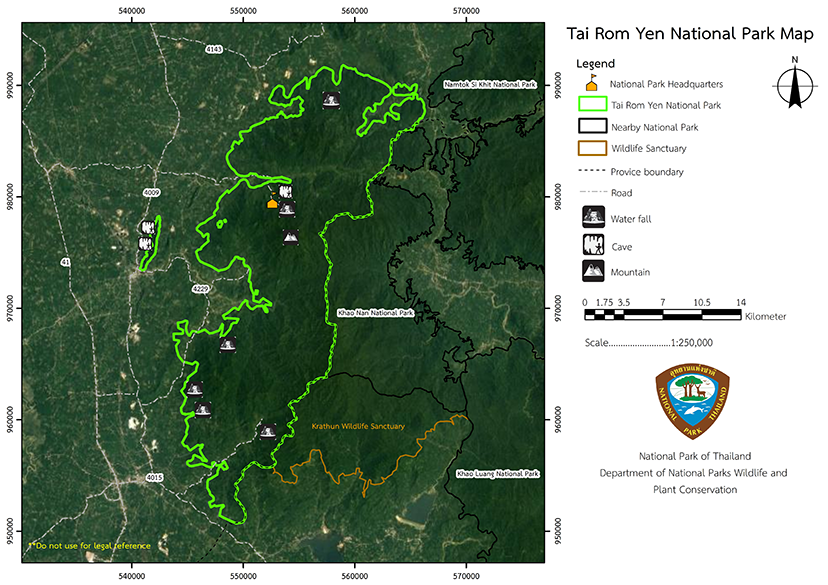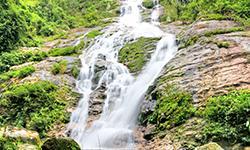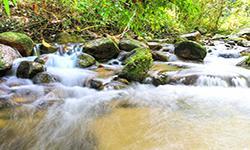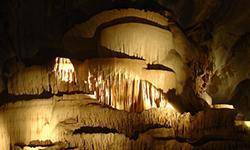Tai Rom Yen National Park
Contact Location : : Tai Rom Yen National Park, Lamphun Sub-district, Ban Na San District, Surat Thani Province, 84120
Telephone Number : (+66) 9 3574 8422
Email : tairomyen_ry@hotmail.com
Facebook : Tai Rom Yen National Park
Information
-
Background
In the past, Khlong Nam Thao National Reserved Forest in the Khao Chong Chang area, Ban Na San District, Surat Thani Province, was the main stronghold of the Communist Party of Thailand (CPT). In 1965, the government began to suppress the movement but was obstructed by the geography and topography of the area. The CPT strengthened and in 1977, Princess Wiphawadi Rangsit was assassinated while traveling on a helicopter with other guests, including the Surat Thani Deputy Governor (Mr. Sawat Phankasem). The attacks continued in the area, with Mr. Surachai Saedan and the CPT forces robbing a train at Phru Phi Station, Surat Thani Province, in 1979, and in 1982, a large bomb destroyed Surat Thani City Hall.
On February 18, 1982, Lt. Gen. Han Leenanon, Commander of the 4th Army Region, launched the "Tai Rom Yen" operation to wipe out the CPT within ten days and clear the area inside three months. The announcement that residents should continue living as normal was made on June 1, 1982 even though there was a severe invasion of the Khlong Nam Thao National Reserved Forest by the CPT.
Consequently, the Lamphun Sub-district Council, Ban Na San District, Surat Thani Province issued a letter dated February 2, 1987, through the members of parliament of the province (Mr. Pasakorn Jaroonrat and Mr. Sittiporn Phophet) requesting the Minister of Agriculture and Cooperatives (Gen. Han Lelanon) for the establishment of a National Park at Plai Nam Nuea, Moo 7, Lamphun Sub-district, Ban Na San District, Surat Thani Province. It is home to the symbolic Dat Fa Waterfall.
The Royal Forest Department sent officials from the National Park Division (Old) to explore and operate, and the official inauguration ceremony of the National Park took place on December 11, 1987, and it was given the name "Tai Rom Yen National Park" by the Minister of Agriculture and Cooperatives (Lieutenant General Han Leenanon), who was the chairman.
In 1991, aroyal decree specified that the land would cover Chai Khram Forest, Wat Pradu Forest - Plot 2, and Khlong Nam Thao Forest in the Chang Sai, Kanchanadit District, Thung Tao, Lamphun and Phru Phi Sub-district, Ban Na San District, and Ban Song Sub-district of Wiang Sa District. It is an area of approximately 425 square kilometers or 265,625 rai, and was named Thailand’s 73rd National Park in the Government Gazette, Volume 108, at 245, dated December
Note : After paying the entrance fee to the National Park, please carry the receipt for inspection.

265,625 rai (425 square kilometers)
|
|
|
||
|
|
|||
Nature trails ⇔ Trekking ⇔ Visit Waterfall ⇔ Wading in the water ⇔ Cave exploration/Geological condition ⇔ Observe flowers/plant ⇔ Take a photo/Video ⇔ Camping ⇔ Relax in a natural
Welfare shop : Not available
- Mueang Thuat Waterfall Area: AIS, TRUE
- Khamin Cave Area: AIS, TRUE, DTAC
- Dat Fa Waterfall Area: AIS, TRUE
|
|
The Tai Rom Yen National Park has a highly complex, folded mountain terrain on a north-south axis, which runs for about 40 kilometers from Kanchanadit District, to Ban Na San and Wiang Sa District, all of which is in Surat Thani Province. The elevations are between 200 meters above sea level in the west to a peak of 1,300 meters above sea level. In the east, the watershed divides the catchment areas of the Tapi River and various canals in Khao Nan National Park, Tha Sala and Phipun District in Nakhon Si Thammarat Province. The highest peak is Khao Nong, which is in the middle of the National Park in Surat Thani province, It is 1,530 meters above mean sea level, and it is the water resource of the Chawang Canal, Ta Phet Canal, Kong Siat Canal, and Lamphun Canal. There are a few limestone mountains scattered in the west, especially in the Ban Na San District, Surat Thani Province.
|
|
There are two seasons, the rainy season, which is between May and December, and the summer, which is between January and April. The average temperature remains constant throughout the year; with the lowest average of 25.0 degrees Celsius in January, and the highest is 27.9 degrees Celsius in April. The maximum temperature was 34.6 degrees Celsius in April and the minimum temperature is 20.3 degrees Celsius in January and February. The annual average temperature is 26.4 degrees Celsius.
|
|
|
|
The plant life in the Tai Rom Yen National Park is mostly tropical rain forest which has a canopy at 30–50 meters high. It is home to notable plant species such as Dipterocarpaceae, Hopea odorata, Parashorea stellata Kurz, Hopea pierrei Hance, Phayom Sai (Shorea roxburghii), and Malacca Teak. The understory layer ranges in height from 15–30 meters and includes plants such as Yangraet. The ground plants are at heights of 5 to 15 meters and consist of Wild Rose Apple, Xerospermum intermedium, Chinese Lantern Tree, and Sugar Palm. The crops and shrubs include ginger, galangal, and various rattans, such as Calamus longisetus, the Three Equal Sepal Renanthera, and Calamus javensis. Wildlife Mammals include large animals such as wild elephants and tapirs, medium-sized animals such as chamois, black bears, jungle cats, gibbons, barking deer, and wild boars, and small animals such as squirrels, Lesser Bamboo Rats, Asiatic Brush-Tailed Porcupines, and Palm Civets. Birds living in the park include the Indian Roller, Great Hornbill, Crested Serpent Eagle, Greater Coucal, Bushy-Crested ornbill, White-Crowned Hornbill, Lesser Racket-Tailed Drongo, Asian Fairy-Bluebird, Coppersmith Barbet, Raffle's Malkoha, Plaintive Cuckoo, Bay Woodpecker, Great Argus, and Common Emerald dove. Reptiles include the Giant Asian Pond Turtle, Snail-Eating Turtle, Asian Forest Tortoise, Elongated Tortoise, Malayan Softshell Turtle, Bengal Monitor, Asian Water Monitor, Spotted Flying Dragon, Black-Bearded Flying Dragon, Red-Headed Lizard, Black-Spotted Smooth Skink, =Many-Striped Skink, Spiny-Tailed House Gecko, Tokay Gecko, Keeled Rat Snake, Vine Snake, Boiga cyanea, and pythons. Amphibians include some that hibernate in the drier months and come out during the rainy season, such as Blyth's River Frogs, Malayan Giant Toads, Tree Frogs, Common Green Frogs, Goose Frogs, Dwarf Toads, and Banded Bullfrogs. |
How to get there by car :
From Surat Thani take Route 4009 (Surat Thani - Na San) for 30 kilometers to Khuan Suban School, then turn left and continue for 15 kilometers to the Tai Rom Yen National Park. (Dat Fa Waterfall)
- National Park Ranger Station Ro Yo No.1 (Mueang Thuat)
- National Park Ranger Station Ro Yo No.2 (Khlong Ngai)
- National Park Ranger Station Ro Yo No.3 (Khlong Tan)
- National Park Ranger Station Ro Yo No.4 (Phet Phanomwat)
- National Park Ranger Station Ro Yo No.5 (Tham Khamin)
- National Park Ranger Station Ro Yo No.6 (Dat Fa)
- National Park Ranger Station Ro Yo No.7 (Mueang Thuat)
Tai Rom Yen National Park offers quite a few lodges for visitors and there is also camping grounds where you can rent tents and equipment. There is also a restaurant available. (Close)



